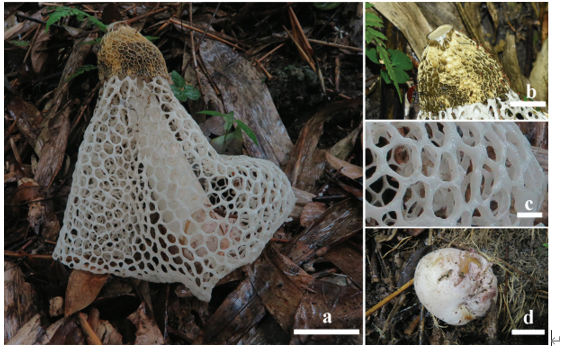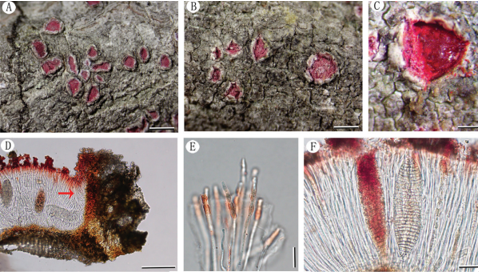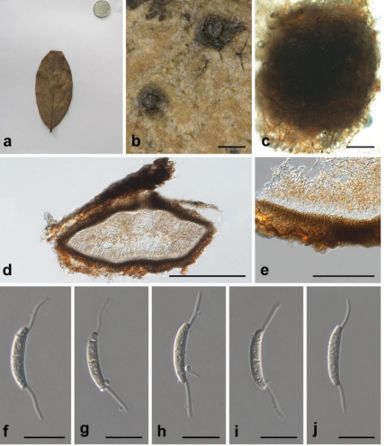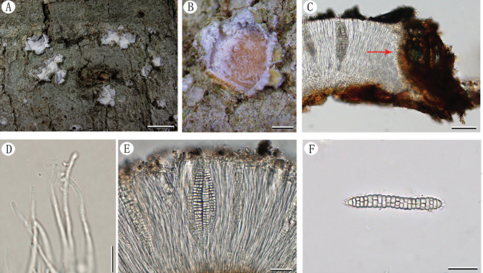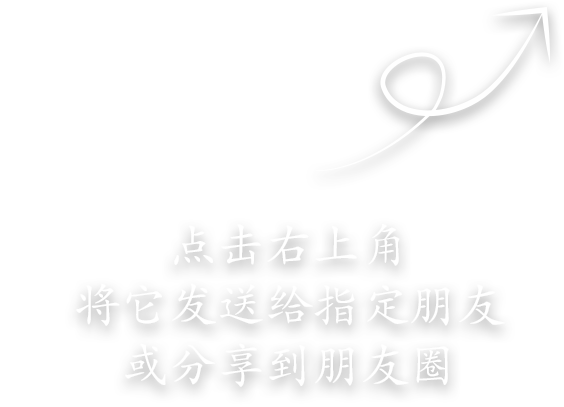Fomitopsis bambusae Y.C. Dai, Meng Zhou & Yuan Yuan, sp. nov.2021
MycoBank No: 839359
Holotype: China. Hainan, Haikou, Jinniuling Park, on dead bamboo, 18.XI.2020, Yu-Cheng Dai leg., Dai 22116 (holotype BJFC036008).
Morphological description
Sexual morph: Fruiting body. Basidiocarps annual, resupinate to effused-reflexed or pileate, separable from the substrate, without odour or taste and soft corky when fresh, corky and light in weight when dry. Pilei semicircular, projecting up to 1 cm, 1.5 cm wide and 5 mm thick at base; resupinate part up to 14 cm long, 6 cm wide and 2 mm thick at centre. Pileal surface bluish-grey when fresh, pale mouse-grey to greyish-sepia when dry, glabrous to slightly velutinate, rough, azonate; margin acute, incurved when dry. Pore surface bluish-grey to pale mouse-grey when fresh, becoming mouse-grey to dark grey when dry; sterile margin up to 1 mm wide; pores round to angular, 6–9 per mm; dissepiments thin, entire. Context white to cream, corky, up to 3.5 mm thick. Tubes paler than pore surface, corky, up to 1.5 mm long.
Hyphal structure. Hyphal system dimitic; generative hyphae bearing clamp con nections; skeletal hyphae IKI–, CB–; tissue unchanged in KOH.
Context. Generative hyphae hyaline, thin- to slightly thick-walled, occasionally branched, 1.5–3 μm in diam.; skeletal hyphae dominant, hyaline, thick-walled with a narrow lumen to subsolid, occasionally branched, interwoven, 2–4.5 μm in diam.
Tubes. Generative hyphae hyaline, thin- to slightly thick-walled, rarely branched, 1.5–2.5 μm in diam.; skeletal hyphae dominant, hyaline, thick-walled with a narrow lumen to subsolid, occasionally branched, flexuous, interwoven, 2–3 μm in diam. Cys tidia absent; fusoid cystidioles present, hyaline, thin-walled, 11–18 × 2.5–4 μm. Basid ia short clavate to barrel-shaped, bearing four sterigmata and a basal clamp connection, 13–19 × 4.5–5.5 μm; basidioles dominant, in shape similar to basidia, but smaller.
Spores. Basidiospores cylindrical to oblong ellipsoid, hyaline, thin-walled, smooth, IKI–, CB–, (4–)4.2–6.1(–6.5) × (1.9–)2–2.3(–2.6) μm, L = 4.917 μm, W = 2.109 μm, Q = 2.26–2.41 (n = 90/3).
Type of rot. Brown rot.
Asexual morph: Undetermined
Culture characteristics:
Habitat:
Distribution: China
GenBank Accession:
ITS MW937874; nLSU MW937881; nuSSU MW937867; mtSSU MW937888; tef1 MZ082980; rpb2 MZ082974
ITS MW937875; nLSU MW937882; nuSSU MW937868; mtSSU MW937889; tef1 MZ082981; rpb2 MZ082975
ITS MW937876; nLSU MW937883; nuSSU MW937869; mtSSU MW937890; tef1 —; rpb2 —
ITS MW937873; nLSU MW937880; nuSSU MW937866; mtSSU MW937887; tef1 MZ082979; rpb2 —
Notes:
Reference: Zhou, M., Wang, C. G., Wu, Y. D., Liu, S., & Yuan, Y. (2021). Two new brown rot polypores from tropical China. MycoKeys, 82, 173.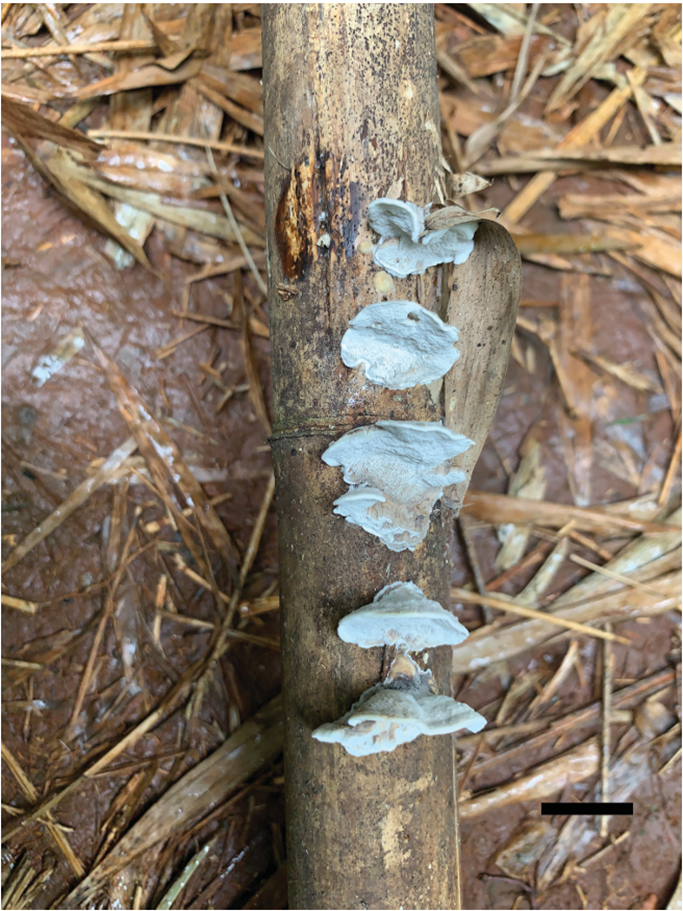
Figure 3. Basidiocarps of Fomitopsis bambusae (holotype Dai 22116). Scale bar: 1.0 cm.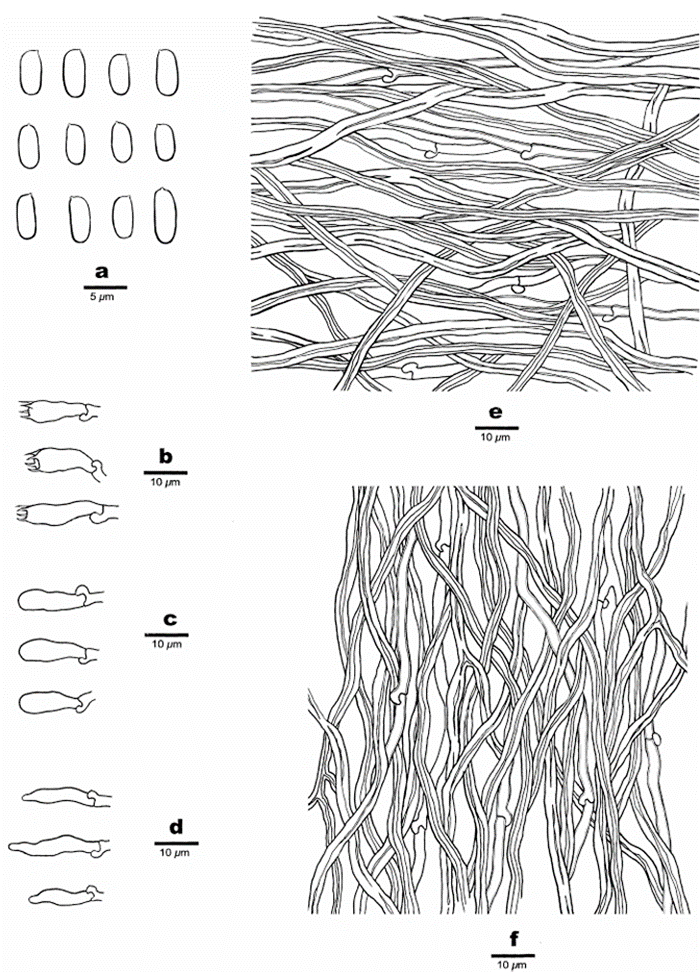
Figure 4. Microscopic structures of Fomitopsis bambusae (drawn from the holotype) a basidiospores b basidia c basidioles d cystidioles e hyphae from context f hyphae from trama.


